INSIDE ISSUE 19.40 | Oct. 2, 2020
 BIG STORY: Redistricting looms as population count ends
BIG STORY: Redistricting looms as population count ends
NEWS BRIEFS: Uh-oh. Trump memo kills offshore wind in S.C., energy group says
SPOTLIGHT: Francis Marion University
COMMENTARY, Brack: Charleston key in Revolutionary, Civil wars
LOWCOUNTRY, Ariail: Not extinct
FEEDBACK: Trump missed Boy Scout values by a mile
MYSTERY PHOTO: Covered bridge
HISTORY: Order a copy of new book of facts today
Redistricting looms as population count ends

By Lindsay Street, Statehouse correspondent | As the U.S. Census comes to a close likely Oct. 5, state lawmakers are readying for a decennial undertaking in 2021: Picking their voters.
“We believe that, perhaps, South Carolina’s biggest problem in redistricting is not the protection of party but the protection of incumbents,” said Lynn Teague of Columbia, vice president of issues and action for the League of Women Voters of South Carolina. “One way or another, it leads to very few competitive districts.”
With only 18 House and Senate races generally seen as competitive in November out of 170 seats up for reelection, Teague said that too many races are settled in the primary or the incumbent faces no challenger at all.
“People should not be drawing their own lines,” Teague said. “We hope to be able to work with the General Assembly to get a decent outcome.”
The process begins
Redrawing of state and congressional districts usually begins in March or April after the 10-year census, and it rests entirely as the power of the state legislature.
More than 98 percent of households nationwide were counted as of Sept. 29, with 96.5 percent of South Carolina households responding. The U.S. Census count was supposed to officially end July 31, but with the coronavirus pandemic, the deadline to count its population was extended to Oct. 5.
- Millions are at stake for local communities when it comes to the census. Learn more here.
The state uses a list of criteria to draw the districts, including compactness, contiguity, preservation of political subdivisions, preservation of communities of interest, preservation of the cores of prior districts, and avoidance of pairing incumbents (See the 2011 redistricting guidelines here). State law does not require public access or input, but maps can be subjected to gubernatorial veto.
The last redistricting process began in April 2011 and ended in June 2011 for state legislative districts and July 2011 for congressional districts. There were no successful legal challenges to South Carolina’s 2011 maps, although at least four actions were filed.
Picking voters
A source familiar with the process of redistricting called it “the most bipartisan thing” at the Statehouse as lawmakers are said to trade neighborhoods to protect their tenure.
Since the 2011 redistricting, a handful of lawmakers have sought to reform how districts are redrawn with no success. Republicans and Democrats have proposed independent commissions and voter-approved redistricting, but those efforts have stalled and died with each session.

Clemson Republican Rep. Gary Clary, who is not seeking reelection this year and was not in office for the 2011 redistricting process, was one of those seeking to change the process in recent years.
“Voters should pick their representatives rather than representatives picking their voters. When you look at the redistricting process, it’s all about power and maintaining control and that’s what we have in redistricting,” Clary told Statehouse Report. “Leadership is not in favor of independent redistricting … People like the status quo when the status quo benefits them.”
Efforts seeking comments for this story from the offices of House Speaker Jay Lucas, R-Hartsville, and Senate President Harvey Peeler, R-Gaffney, went unanswered.
‘Continue to fight the fight’
Teague said her organization will work with experts at Clemson, the University of South Carolina, and AARP to obtain the same software that the state is using to draw its districts. With that software, the league will generate its own maps using population data “to inform the public very closely what is happening with their districts,” she said.
 The league found the 2011 redistricting did not violate partisan gerrymandering rules — something that tripped up North Carolina’s redistricting effort — but it did protect incumbents.
The league found the 2011 redistricting did not violate partisan gerrymandering rules — something that tripped up North Carolina’s redistricting effort — but it did protect incumbents.
Teague said incumbent protection leads to polarization and fewer compromises in government, and also means lawmakers don’t have to listen to a variety of voices that represent America.
“We think competitive districts are a good thing and we have very few of them at the moment,” Teague said. “Voters should have a choice. They shouldn’t go into the polling place in November with no meaningful choice.”
Clary said it comes down to power.
“I’ve never been in the map room where they draw the lines, but I do know enough about it that if I can go in and adjust my line, that’s closely akin to a lawyer being able to put his finger on the scales of lady justice,” said Clary, a former circuit court judge. “It all boils down to no one is willing to give up the power they wield in being able to draw these districts.”
And, he added, don’t expect the courts to wrest control of redistricting from the legislature.
“Unless there is some flagrant disregard of criteria used for drawing district lines then the courts are not going to intervene unless there is some sort of egregious attempt at gerrymandering,” Clary said.
To his colleagues interested in changing the system, Clary offered this:
“Continue to fight the fight. It’s an uphill battle. As the old saying goes, it’s swimming upstream. Unfortunately, I do not see any change that’s going to be made there.”
- Have a comment? Send to: feedback@statehousereport.com
Uh-oh.
Trump memo kills offshore wind in S.C., energy group says

By Lindsay Street, Statehouse correspondent | A presidential memorandum that halts offshore drilling and testing off South Carolina waters also puts an end to the burgeoning offshore wind industry, clean energy advocates say.
The memo initially seemed to be good news for conservationists: President Donald Trump signed earlier this month a memo halting new leases for offshore drilling exploration for South Carolina, North Carolina, Georgia and Florida from July 1, 2022, until June 30, 2032.
Sure, it could easily be undone with another memo, it doesn’t apply to any current leases already issued and it wouldn’t stop seismic testing completely. But it was something and appeared to be in the direction South Carolina officials have pushed: putting an end to chants of “drill, baby, drill” in Palmetto waters.
The Southern Alliance for Clean Energy’s (SACE) Chris Carnevale of Charleston said he was “surprised” by the moratorium.
“When that came out, my brain was not even thinking about offshore wind,” he said.
Turns out, that got banned too, Bloomberg News reported this week.
“The withdrawal includes all energy leasing, including conventional and renewable energy, beginning on July 1, 2022,” Bureau of Ocean Energy Management spokeswoman Tracey Moriarty told Bloomberg News.
South Carolina has been hailed as a potential offshore wind energy leader in recent years. A 2019 report said the state could land a $70 billion industry, create thousands of jobs, and generate more power than its consumers needed.
“South Carolina has worked for over a decade to get prepared for offshore wind energy,” Carnevale said. “We have a number of businesses in South Carolina that are in the wind energy supply chain.”
North Charleston is home to a wind turbine research center with Clemson University, making it a key spot for wind power innovation.
“Delaying or halting development of local offshore wind energy could mean potentially less of a developing local market for the facility,” said SACE’s Jennifer S. Rennicks of Asheville.
Carnevale said the Trump memo shows that elections have consequences.
“(The ban) can be undone as easily as it was done,” Carnevale said. “With a stroke of a pen, he can just change it … It is in the hands of the president.”
In other news:
![]() Witness signatures not* required on absentee ballots. The asterisk says it all: The fight over whether witness signatures will be required on absentee ballots in South Carolina continued this week. It landed in The Washington Post and on the Supreme Court of the United States blog. As of Friday morning: You don’t need a witness signature on your absentee ballot, but perhaps you should consider this popular wisdom: “It’s better to have it and not need it, than to need it and not have it.”
Witness signatures not* required on absentee ballots. The asterisk says it all: The fight over whether witness signatures will be required on absentee ballots in South Carolina continued this week. It landed in The Washington Post and on the Supreme Court of the United States blog. As of Friday morning: You don’t need a witness signature on your absentee ballot, but perhaps you should consider this popular wisdom: “It’s better to have it and not need it, than to need it and not have it.”
Legislature sees (slightly) fewer old white guys over five years. Older white men make up 6.2 percent of South Carolina’s population (calculation: 18.2 percent of S.C. population is over 65, 68.6 percent is white and 49.4 percent is male) and yet make up nearly 64 percent of the state legislature. But that number has been changing. In 2015, the General Assembly was 86 percent male, 76 percent white and 67 percent were born before 1965. Five years later, it’s now 84 percent male, 74 percent white and 54 percent were born before 1965. A 2 percent change reflects about three or four members. At this rate, the state will see a legislature reflecting the population in … forever away. See more about the somewhat changing demographics here.
Report says salary changes needed to retain teachers. A new report from the Southern Regional Education Board found states should continue to raise teacher pay, and improve benefits and other types of support, particularly in the pandemic. “Even while state revenues lag during the pandemic, states and schools can take immediate steps to support educators and keep teacher shortages from worsening,” the report said. Read the report here.
McMaster signs firefighter bill. Gov. Henry McMaster signed a bill on Tuesday that will support firefighters diagnosed with cancer. Read more.
Judge stops payment of $75M of SRS funds to law firms. S.C. Circuit Court Judge Debra McCaslin has temporarily blocked private attorneys from receiving $75 million of a settlement with the federal government over nuclear material at the Savannah River Site. Read more.
- Have a comment? Send to: feedback@statehousereport.com
Francis Marion University
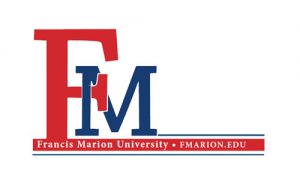 The public spiritedness of our underwriters allows us to bring Statehouse Report to you at no cost.
The public spiritedness of our underwriters allows us to bring Statehouse Report to you at no cost.
We’re happy this week to shine our spotlight on Francis Marion University, a public university located in Florence, S.C. It was founded in 1970 with a mission to provide the people of the Pee Dee, and of South Carolina, with high quality, yet accessible, university education. FMU has stayed true to that mission for nearly 50 years. In any given year, more than 95 percent of the university’s students are South Carolinians, and FMU is, by most measures, the most affordable college in the state.
Francis Marion University is, of course, named for Revolutionary War hero, General Francis Marion, who was nicknamed “The Swamp Fox” for his uncanny ability to use terrain, local knowledge and just plain old South Carolina common sense to outfox the British. Today, FMU prides itself on providing a strong liberal arts education for its 4,000 students, while at the same preparing them for careers in a broad range of fields.
The University offers professional schools in health care, education and business, as well as graduate programs in business, education and psychology. FMU’s new School of Health Sciences is adding new programs, designed to help deliver critical medical services to the community, on an almost annual basis, so great is the demand by students and the need in our region and state. Recent undergraduate additions to the University as a whole include Health Care Management and Industrial Engineering. The latter, just begun in 2014, is already one of the fastest-growing majors on campus.
The campus is situated on over 400 wooded acres of beautiful foliage and landscaping. A significant campus presence in historic downtown Florence is also developing. FMU’s Performing Arts Center is located there along with the Carter Center for Health Sciences, and the FMU Recording Studio, The University recently acquired more downtown property near the Carter Center, which will help support future academic expansions.
FMU has managed to grow while at the same time providing South Carolinians with, as noted, an affordable university education. FMU’s total net cost — tuition plus room, board and other fees, less scholarships and grants awarded — is South Carolina’s lowest, and by a considerable margin, according to calculations performed by a third party, CollegeFactual.com. FMU has managed this unusual balance of quality and affordability by avoiding capital debt, minding administrative costs carefully, and developing a culture of giving among its many friends and supporters in the Pee Dee and beyond.
- To learn more about Francis Marion, visit online at fmarion.edu
Charleston key in Revolutionary, Civil wars
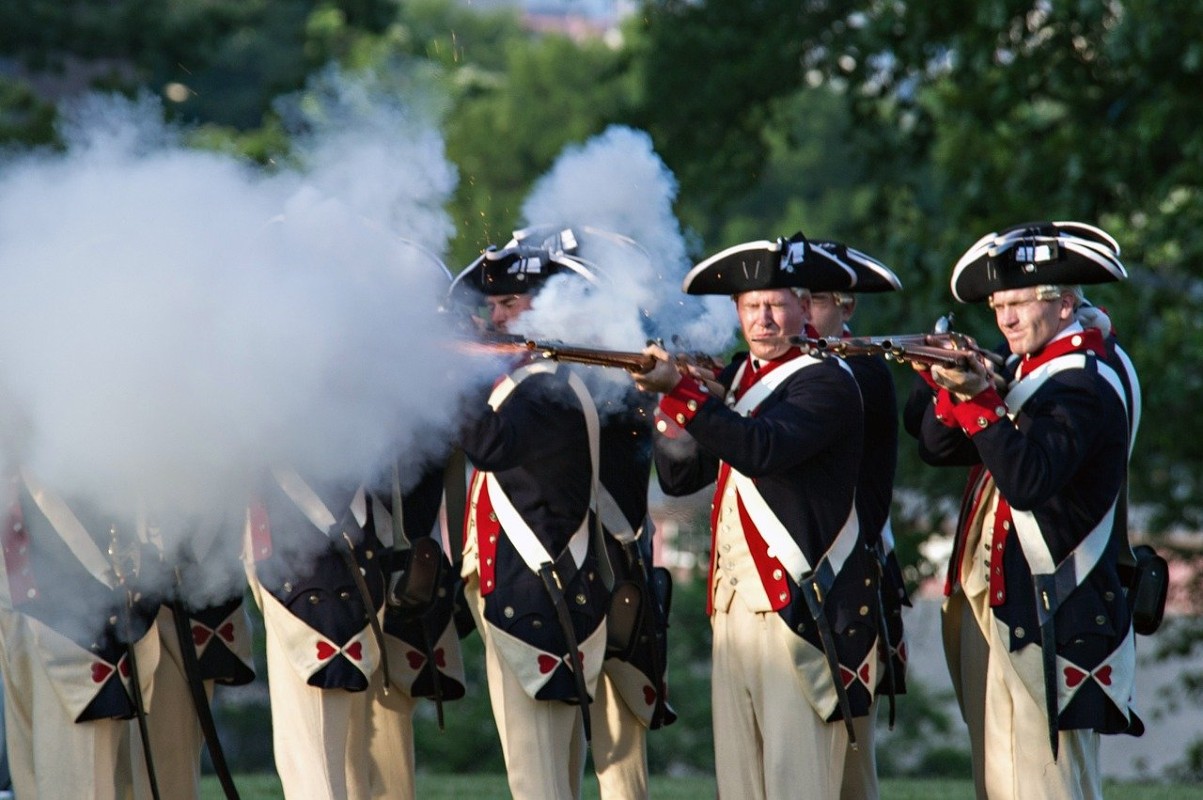
By Andy Brack | Bring up past American wars and it’s pretty certain you’ll soon get into a disagreement about something. Example: Which was more important — the Revolutionary War or the Civil War?
 Some people focus mostly on the Revolutionary War, saying without the success of patriots in South Carolina and other colonies that we may not have been able to test our unique experiment with democracy.
Some people focus mostly on the Revolutionary War, saying without the success of patriots in South Carolina and other colonies that we may not have been able to test our unique experiment with democracy.
Others intently study the complexities of the Civil War, its strategies, its inventions, its terrible tool and its enduring impact being felt in society today in everything from polarized bickering about the Confederate flag to racially-motivated killings and violence.
Part of the newly-released 350 Facts About Charleston highlights the influential roles of people and events in the Holy City during these two deadly conflicts. Here’s a preview:
Third time was charmed for British
The British failed in the first attempt to take Charleston in 1776 in what was the first major naval victory for patriot forces. South Carolina troops repelled an attack on a palmetto fort on Sullivan’s Island. Three years later, the British made a second attempt to capture Charleston while the main Continental Army was in Georgia. British Gen. Augustine Prevost marched from Savannah to Charleston, but as Gen. William Moultire’s small force was holding its own, the Continental Army returned from Georgia, fighting back the British.
The Redcoats mounted their strongest attempt to take the Holy City in 1780 when Sir Henry Clinton’s 10,000-man army, supported by the Royal Navy, laid siege to the city from April 1 to May 12. It was the longest siege of the Revolutionary War. It ended when Charleston and 6,000 colonial soldiers surrendered. The loss is considered the worst defeat of the Continental Army during the Revolutionary War and gave the British a foothold to try to retake the Southern states.
Favorite story in the book
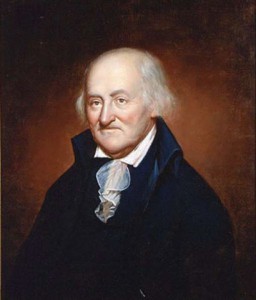
Charleston patriot Christopher Gadsden, remembered today for his yellow “Don’t Tread On Me” rattlesnake flag, first advocated for colonial independence from the British in 1766 under a live oak that would come to be known as the Liberty Tree. A bronze plaque by the Sons of the Revolution marks the spot near Alexander Street where the tree once stood. Gadsden, along with his fellow revolutionaries, led public meetings to protest the British Stamp Act and tea tax, calling themselves the Sons of Liberty.
So here’s where the story about the Liberty Tree gets interesting. When the British occupied Charleston from 1780 to 1782, they cut down the Liberty Tree and burned its stump to prevent it from becoming a patriot shrine. But they didn’t think about the tree’s pesky roots. After the war, Judge William Johnson retrieved a root and had it made into cane heads. One of them was given to Thomas Jefferson, author of the Declaration of Independence. Pretty neat, huh?
No deaths during “shots heard around the world”
On April 12, 1861, Confederates opened fire on Fort Sumter at 4:30 a.m. from multiple positions surrounding the fort — but not from the peninsula as many believe. Thousands of spectators filled rooftops and lined the Battery to watch the barrage. After the 34-hour bombardment, Union Major Robert Anderson, commander of Fort Sumter, surrendered. Incredibly, no one died during the engagement in which more than 3,000 shells were fired. It wasn’t until an accidental explosion during the surrender ceremony that the first casualty of the Civil War, Daniel Hough, a Union soldier, was claimed.
Fort Sumter remained an important bastion after the first barrage
Confederate forces continued to occupy Fort Sumter, using it to hold a defense of Charleston Harbor after P.G.T. Beauregard captured the bastion in 1861. Better armed and finally finished, the fort allowed the Southern military to create a valuable hole in the Union blockade of the Atlantic seaboard. Two years later, in 1863, the Union would launch its first assault against Fort Sumter, when Rear Admiral Samuel Francis Du Pont attempted a naval attack on the port city of Charleston. He arrived in Charleston with a fleet of nine ironclad warships, but in collaboration with Fort Sumter, Confederate batteries commanded by Beauregard unleashed a barrage of cannonfire against the fleet, dealing over 500 hits and forcing the fleet to retreat.
You can find out more about the book online at CharlestonFacts.com.
- Andy Brack is editor and publisher of Statehouse Report. His column also is published in the Charleston City Paper, Florence Morning News, Greenwood Index Journal, The (Seneca) Journal, Camden Chronicle Independent and Hartsville Messenger. Have a comment? Send to: feedback@statehousereport.com.
Not extinct
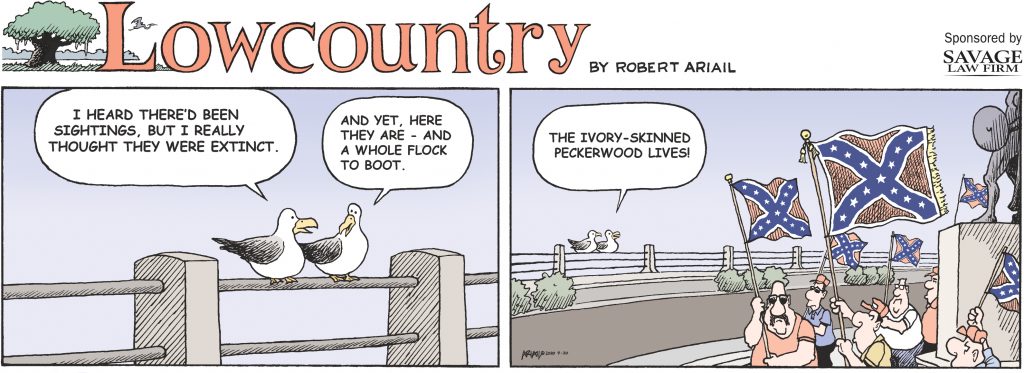
Enjoy this week’s cartoon by Robert Ariail, republished from our sister newspaper, the Charleston City Paper. Love it? Hate it? What do you think: feedback@statehousereport.com.
Trump missed Boy Scout values by a mile
To the editor
![]() The Boy Scout values are from the time that Trump claims he is going to bring us back to. Missed it by a mile.
The Boy Scout values are from the time that Trump claims he is going to bring us back to. Missed it by a mile.
Using these values that many of my age can recall is quite a good way to fairly put a magnifying glass to the guy. Well done by you.
Clearly the orange-man failed.
— Fred Palm, Edisto Island, S.C.
“My esteemed colleague”
To the editor:
What a strange sense of joy to read your column as it appeared two days after I submitted my letter to the Florence News. I addressed the exact same issues as you brought up about the single greatest threat, and poor substitute for a human being, to our Democratic form of government.
Trump is, in my mind, the “orange man in the White House” or “the man elected by a minority of American voters.” Thanks for being a voice of reason and common sense, two things lacking in our very sad state of political turmoil. I will call you “my esteemed colleague” a term that has been totally abandoned by our current government.
— Harvey N. Brown, Florence, S.C.
Send us your thoughts
We love hearing from our readers and encourage you to share your opinions. But to be published, you’ve got to provide us with contact information so we can verify your letters. Letters to the editor are published weekly. We reserve the right to edit for length and clarity. Comments are limited to 250 words or less. Please include your name and contact information.
-
- Send your letters or comments to: feedback@statehousereport.com
Covered bridge
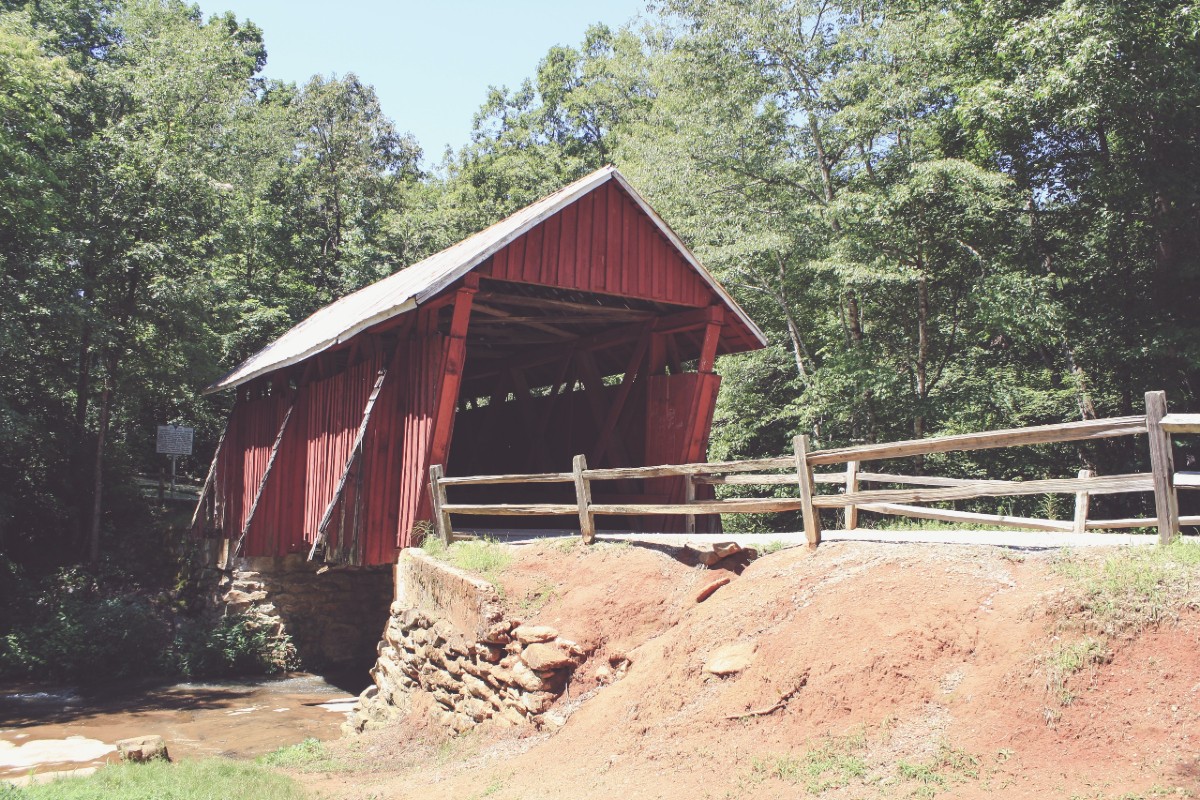
Where is this covered bridge and what can you tell us about it? Send to feedback@statehousereport.com. And don’t forget to include your name and the town in which you live.
Our previous Mystery Photo
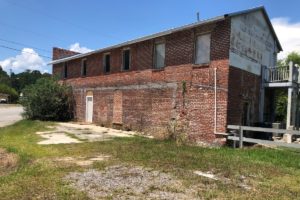 Our Sept. 25 photo, “Old building with interesting former life” shows a building that’s just a few yards from the Yemassee train station where hundreds of thousands of recruits met Marine Corps drill sergeants before heading to basic training at Parris Island. The photo, sent by Florence reader Barry Wingard, shows the building in disrepair, although it apparently is being used as a church today.
Our Sept. 25 photo, “Old building with interesting former life” shows a building that’s just a few yards from the Yemassee train station where hundreds of thousands of recruits met Marine Corps drill sergeants before heading to basic training at Parris Island. The photo, sent by Florence reader Barry Wingard, shows the building in disrepair, although it apparently is being used as a church today.
This was a tough one, so congratulations to these three eagle eyes for identifying the photo: Vicki Ringer of Columbia; Bill Segars of Hartsville; and George Graf of Palmyra, Va.
Graf shared that the “building was built in 1912 and served as a general merchandise store and also served as a receiving station for U.S. Marine recruits.”
Send us a mystery: If you have a photo that you believe will stump readers, send it along (but make sure to tell us what it is because it may stump us too!) Send to: feedback@statehousereport.com and mark it as a photo submission. Thanks.
New history of Charleston is now in stores
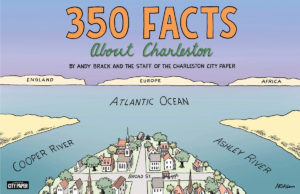 Copies of a new book of historical facts about Charleston, aptly titled 350 Facts About Charleston, are in Lowcountry-area bookstores now, but if you can’t swing by, you can order a copy online today.
Copies of a new book of historical facts about Charleston, aptly titled 350 Facts About Charleston, are in Lowcountry-area bookstores now, but if you can’t swing by, you can order a copy online today.
The staff at our sister publication, the Charleston City Paper, pulled together fun and arcane information about the Holy City to illuminate its deep, rich history from its founding in 1670 until this year. (That’s, umm, 350 years!)
Charleston historian and tour guide Damon Fordham this week got a copy of the book and remarked, “very informative and worth the read.” Charleston disc jockey Richard Todd (105.5 The Bridge) told listeners he thought the book was great and will be popular.
Included in the 224-page book are details on early settlers, the wars (Revolutionary and Civil) and the struggle for civil rights by descendants of enslaved Africans. You’ll learn about food (Charlestonians have loved to drink wine for centuries), books, people, music, culture and much more.
Bonus: Talented South Carolina cartoonist Robert Ariail offers 12 illustrations that should make a great calendar someday.
- Preview and order the book by visiting CharlestonFacts.com.
ABOUT STATEHOUSE REPORT
Statehouse Report, founded in 2001 as a weekly legislative forecast that informs readers about what is going to happen in South Carolina politics and policy, is provided to you at no charge every Friday.
Meet our team
- Editor and publisher: Andy Brack, 843.670.3996
- Statehouse correspondent: Lindsay Street
Donate today
We’re proud to offer Statehouse Report for free. For more than a dozen years, we’ve been the go-to place for insightful independent policy and political news and views in the Palmetto State. And we love it as much as you do.
But now, we can use your help. If you’ve been thinking of contributing to Statehouse Report over the years, now would be a great time to contribute as we deal with the crisis. In advance, thank you.
Buy the book
Now you can get a copy of editor and publisher Andy Brack’s We Can Do Better, South Carolina! ($14.99) as a paperback or as a Kindle book ($7.99). . The book of essays offers incisive commentaries by editor and publisher Andy Brack on the American South, the common good, vexing problems for the Palmetto State and interesting South Carolina leaders.
More
Mailing address: Send inquiries by mail to: 1316 Rutledge Ave., Charleston, SC 29403
Subscriptions are free: Click to subscribe.
We hope you’ll keep receiving the great news and information from Statehouse Report, but if you need to unsubscribe, go to the bottom of the weekly email issue and follow the instructions.
Read our sister publications: Charleston City Paper (every Wednesday) | Charleston Currents (every Monday).
© 2020, Statehouse Report, a publication of City Paper Publishing, LLC. All rights reserved.















 We Can Do Better, South Carolina!
We Can Do Better, South Carolina!